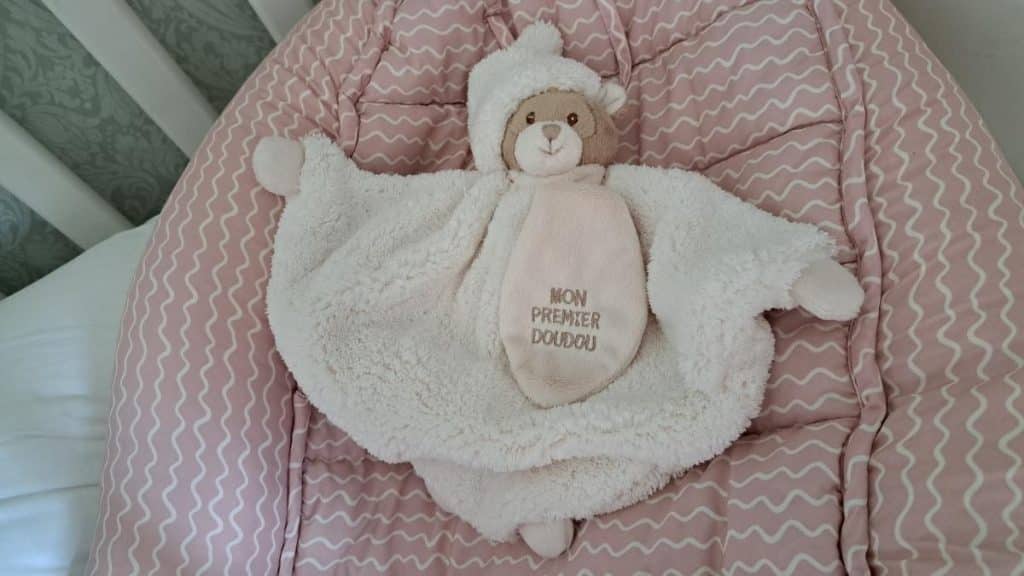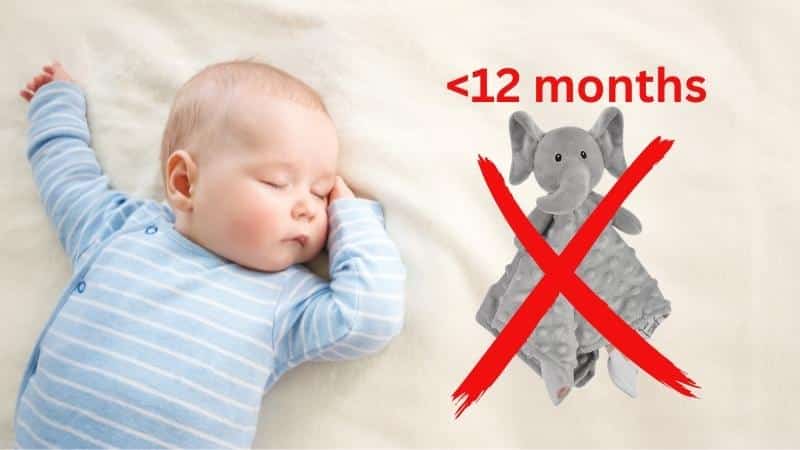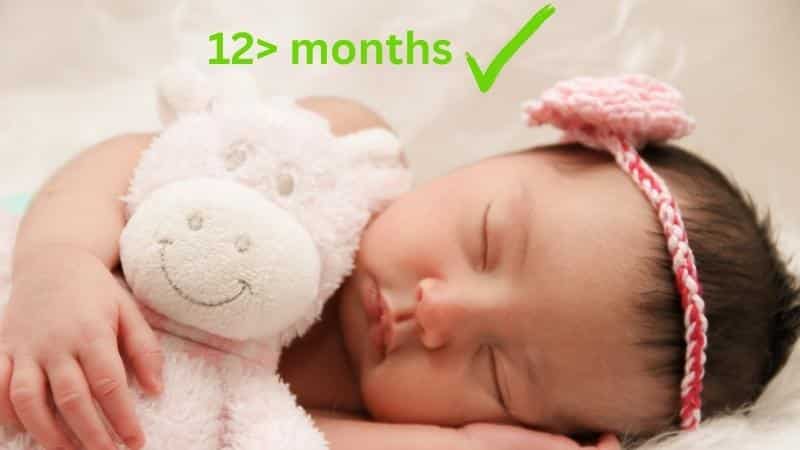There will be a great deal of development in the infant’s first year. These are all new experiences for your newborn as he or she makes the leap from the womb to the family home.
There are several challenges that newborns must face, including adjusting to their new environment, learning to sleep independently, and mastering their bodies.
There are numerous variables outside of our sphere of influence. However, there are ways we might help mitigate the difficulties our child faces.
A lovey or security blanket is a simple method to comfort a young child while he or she adjusts to the many changes that will be occurring in the first year of life. But when and how should one go about using items such as a lovey?
What is a Lovey?

A lovey (also written lovie) is a transitional object consisting of a blanket and plush animal, comparable to a security blanket. Babies’ lovies and security blankets are designed to ease their anxiety.
Transitional objects or comfort objects are known for aiding a child in the process of becoming emotionally and psychologically independent from their parents. A transitional object can be anything the youngster develops an attachment to, from a favorite blanket to a little stuffed animal.
When your child is experiencing separation anxiety, a lovey might help them feel more secure. Infants’ mothers and the outside world can communicate more effectively with the help of comfort objects.
The child’s sense of autonomy and self-confidence increases as a result of these reassuring experiences, even as the youngster grows to feel more comfortable in previously unsettling situations.
When Can Your Baby Start to Safely Sleep With a Lovey?
Your child’s development and personality will determine the appropriate moment for you to give them a stuffed animal or lovey as a gift. It is important to take into account both your motor abilities and your strength. If you have any questions or concerns, you should always visit a pediatrician.
A child as young as four months old can be given their first lovey, but the lovey, stuffed animal or other objects that the child finds solace in should be taken from the crib as soon as the infant begins to nod off.
It may also be too soon for some youngsters to begin to build a connection at this age. The majority of newborns are not emotionally mature enough to form an attachment to an inanimate object until they are close to nine months old. However, this varies from child to child.
According to Dr. Natalie Barnett, a specialist in the field of pediatric sleep science, the ideal time to give a baby their first lovey is around twelve months. No exclusions!
The American Academy of Pediatrics has a straightforward recommendation regarding newborn sleep:
“Keep soft things, loose bedding, or any objects that might enhance the risk of entanglement, suffocation, or strangling out of the baby’s sleep space,” they suggest. “Nothing else should be in the bed except for the infant.” Some of the additional reasons for this recommendation include the following:
Loveys are more suitable when your child is in a toddler bed.
It is ideal to wait until your child is sleeping in a toddler bed, which is a non-enclosed room, before introducing a lovey as a sleeping companion. This will ensure the highest level of safety. When the child is 15 months old, parents can start using toddler beds.
Moro reflex must have become less prominent.
Additionally, the Moro reflex, often known as the startle reflex, will have subsided by this point, meaning that your infant will no longer need to be swaddled.
Why Aren’t Loveys Safe for Infants to Sleep With?

Babies should not be left alone with lovies because of the risk of asphyxia. The American Academy of Pediatrics reports that “a high majority of infants who die of SIDS are found with their head buried by blankets.” The majority of crib deaths, according to the CPSC, are caused by “the inclusion of extra bedding like pillows, blankets, and/or comforters, among others.”
This means that you can’t trust any so-called “baby security blankets” to keep your child secure while they sleep. You say lovies isn’t safe for sleep, but how about all the experts who say otherwise? There are some habits that even seasoned doctors can’t always determine are dangerous simply by looking at them.
That’s what sets SIDS apart from concerns about baby health and safety in general. Because sudden infant death syndrome is so uncommon, studying its causes requires looking at huge populations objectively.
The accumulation and analysis of massive quantities of data on SIDS incidents led to the discovery of many of the things we now take for granted in terms of preventing SIDS. (For instance, it was not always known that it was best to put a baby to sleep on his back.)
Here’s the point:
- The risk of a whole community cannot be extrapolated from the experience of a single person, not even a pediatrician.
- It’s important to remember that even if a sleeping environment seems harmless for an infant, that doesn’t necessarily imply it is.
We must let scientific proof (from large-scale research) guide the potentially life-or-death decision of whether or not to allow infants to sleep using security blankets.
List of Alternatives to a Lovey
Loveys are wonderful for putting your baby to sleep, but there are significant dangers associated with them, as we covered earlier. Are you looking for the most effective alternatives to making use of a Lovey?
According to Dr. Ahmann, lullabies and rocking your child to sleep are two of the most effective methods for calming an infant. However, any sort of sensory soothing can be effective. Experiment with the following:
- Swaddling.
- Massage.
- Any gentle movement that is repeated multiple times, such as swaying or swinging.
- Feeding(not till they fall asleep, but until they start to become sleepy).
- Turning down the lights.
- playing soothing music or using a white noise machine or software to play noises that are calming. (Shut off the television.)
How to Introduce a Lovey at Bedtime?

It may take some time for a youngster to become attached to a lovey, but it doesn’t mean they won’t eventually. And other kids, no matter how many you buy, just can’t seem to latch on to any of them!
But we do have some suggestions that might help your kid develop that attachment:
1. Sleep with the Lovey
If you want to leave your scent on the lovey, you should wear it and sleep with it for a day or two. Don’t be bashful about letting it take in your scent. It will bring your child peace. Put it in your bra and take a stroll. Carry that odor around with you.
2. Help your child play with it
While you hold your child close and feed them, play with their lovey. As a bonus, this helps children stay concentrated on their meals rather than look at the actions around them.
3. Make your child cuddle Lovey while doing another bedtime routine
You can have them snooze and go to sleep cuddling with it as you read to or sing to them. Try holding it in the crook of your neck first to see if that piques their interest before giving it to them.
4. Tuck both your child and lovey in
Tuck the lovey into their arms as you put them to bed or check on them in the middle of the night. They won’t just “get it” that the lovey is intended for cuddling purposes. You can demonstrate this by giving it to them to hold.
5. Treat the lovey like a friend
As you tuck your small one into bed, say, “goodnight (special lovey name)” and give him a kiss and a hug with the lovey before he or she goes to sleep.
Particularly when they’re young, it’s best to limit it to bedtime. Kids lose it because as they become older, they want to engage in more imaginative play with them (adorable!).
Is There Breathable Loveys? And Are They Even Safe?
You may have fallen for the “breathable” marketing gimmick in your search for a non-hazardous lovey for your child. The term “breathable” has no official definition or standards. No criteria exist for evaluating the effectiveness of carbon dioxide retention.
Without testing or even a clear definition of the phrase, any manufacturer can declare that their product is breathable. More so, there is no proof that “breathable” infant items lessen the incidence of SIDS.
Are there any Safe Sleeping Toys for Babies?
Any of the safe sleeping toys that are available cannot be used by infants who are younger than 12 months old. The only conceivable exception to this rule is a pacifier, which you might or might not think of as a sleep aid.
If you want to lower the risk of sudden infant death syndrome (SIDS) and other sleep-related deaths, you should make sure that your baby’s crib is completely devoid of any objects, except a pacifier.
What About Stuffed Animals? Are They Safe for Babies to Sleep With?
Stuffed animals are subject to the same restrictions. There is absolutely no such thing as a stuffed animal that is breathable or safe to leave in your baby’s bed if he is under the age of one year old.
When is it safe for a baby to go to bed with a stuffed animal? At the age of 15 months or more, a baby can transition to a toddler bed and sleep with a tiny stuffed animal.
